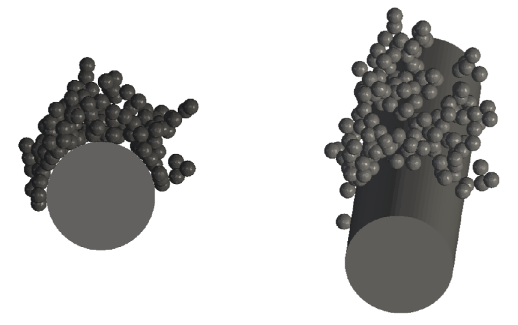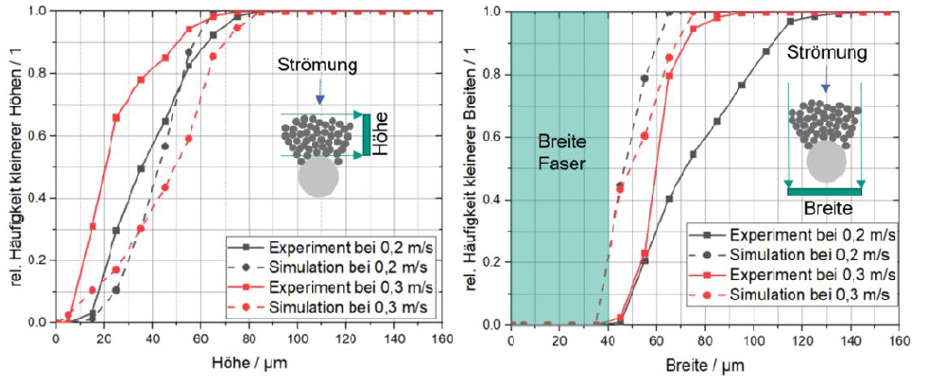Experimental and numerical investigation of the formation, rearrangement and re-entrainment mechanisms of reactive-inert particle structures in the case of flow around cylindrical collectors in a gaseous environment
Principal investigator: Prof. Dr.-Ing. Uwe Janoske
Project manager/Main research: Prof. Dr.-Ing. Uwe Janoske
Researchers: Kamil Braschke, Amin Zargaran
Title of research project: Experimental and numerical investigation of the formation, rearrangement and re-entrainment mechanisms of reactive-inert particle structures in the case of flow around cylindrical collectors in a gaseous environment
Funding: DFG
Project partners: Karlsruher Institut für Technologie (KIT) - Arbeitsgruppe Gas-Partikel-Systeme
Project endurance: February 2020 – February 2022
Project area: Mechanical Process Engineering
Cluster: Pleiades
Software: OpenFOAM-5, own C++ library for an Immersed Boundary Method


Introduction:
A mixture of reactive and inert components within particle structures can be found in many technical applications. One example is soot (reactive) and ash (inert) in porous filters during the filtration of exhaust gases, another is coal dust (reactive) and ash (inert) in packed bed reactors for the gasification of coal dust. In such applications it is possible for deposited particles to detach from the collector and to be transported further through the porous medium. Flow induced re-entrainment procedures from collectors have already been described in literature for the case of only reactive or only inert deposit structures. So far, the detachment of inert particles from single fibers has only been found for superficial velocities above 1 m/s. However, the influence of an additional reactive component on the detachment velocity has not been investigated, yet. Early measurements have shown that the detachment of particle deposits, consisting of soot and glass, can be reduced from a superficial velocity of 3.5 m/s to 0.48 m/s when the ambient temperature is increased from 22°C to 410°C. Additionally, a rearrangement of deposited structures can be observed. The aim of this research project is to analyze the influence of parameters like flow velocity, temperature, collector diameter, fiber loading, proportion of reactive and inert constituents, morphology of particle structures, diameter of monodisperse inert particles on the detachment of particles or particle structures. Before the results can be applied to various porous filtration media, it is necessary to validate developed numerical models for the case of a cylindrical collector.
Methods:
The gaseous phase is calculated within the opensource CFD software OpenFOAM® which utilizes a finite volume method for the computation of its conservative equations. In this method the computed domain is divided into a magnitude (in our case several millions) of smaller volumes to which the relevant fluid mechanical equations are applied. For the representation of the disperse (solid) phase the chair of fluid mechanics developed its own Immersed Boundary Method C++-library called ABSFoam. It interpolates forces from OpenFOAM’s fluid field to the surface of the immersed bodies and thereby determines the solid bodies’ new kinetic properties. Further, the surface-based implementation of ABSFoam enables a shape independent calculation of collision mechanics between particles or particles and collectors and also provides multiple methods for the determination of adhesive forces between arbitrarily shaped bodies. An example of a deposited structure together with its collector is given in Figure 1.
Results:
Multiple simulations for the deposition of particles on a cylindrical fibre have been calculated for various flow conditions and material properties. Some results for the particle deposition are shown in Figure 2. It depicts the relative occurrence of deposited particle height and width for two superficial velocties and compares them to experimental measurements.
Discussion:
Multiple simulations for the deposition of particles on a cylindrical fibre have been calculated for various flow conditions and material properties. Some results for the particle deposition are shown in Figure 2. It depicts the relative occurrence of deposited particle height and width for two superficial velocties and compares them to experimental measurements.
Outlook:
With new improvements to the parallelization of ABSFoam and greater computational resources available the next step consists of an investigation of the bridge building of deposited reactive and inert particles between multiple fibers, as well as the re-entrainment of said structures. Such an arrangement is closer to the application of an actual filter and the constructed particle bridge represents new circumstances under which larger particle chunks can re-entrain. In particular early numerical investigations have shown that a particle structure, which is oriented perpendicular to the flow direction, experiences a larger fluid force than in a parallel orientation and therefore appears more prone to (partly) break. In order to deal with the large count of required reactive soot particles the model will be extended to also include the discrete element method and a coupling to ABSFoam and OpenFOAM.
Kamil Braschke, Julian Zoller, Amin Zargaran, Achim Dittler & Uwe Janoske Analytical and numerical calculation of the detachment of particle structures from fibers, Aerosol Science and Technology, (2021) DOI: 10.1080/02786826.2021.1972085
K. Braschke and U. Janoske Eine Immersed Boundary Methode zur Berechnung komplexer Partikelinteraktionen für volumetrisch aufgelöste Partikel. In NAFEMS: Neue Methoden in der numerischen Strömungsberechnung (CFD) – Alternativen zu Finite-Volumen-Methoden? (2018)
Zoller, J., Zargaran, A., Braschke, K. et al. Experimental Investigation of Reactive-Inert Particulate Matter Detachment from Metal Fibres at Low Flow Velocities and Different Gas Temperatures. Aerosol Sci Eng 5, 21–31 (2021). DOI: 10.1007/s41810-020-00081-3